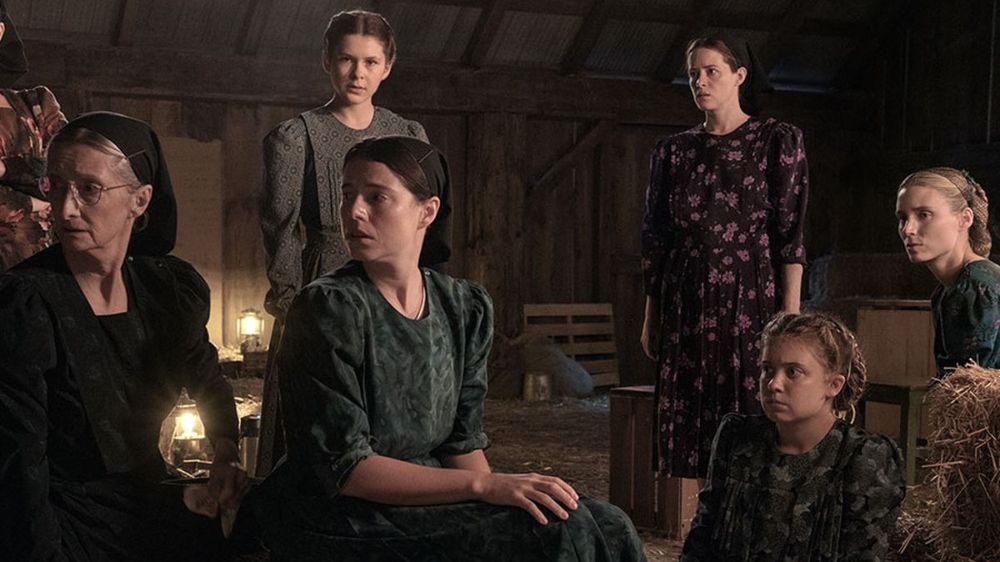
Miriam Toews’ 2018 novel Women Talking presents a fascinating and thought-provoking scenario partially inspired by real-life events at a Mennonite colony where a group of men repeatedly attacked and sexually assaulted more than 100 women. Bringing that story to the screen was no doubt a difficult task, one for which writer-director Sarah Polley was particularly well-suited.
To ensure that the film had the proper look and feel, Polley brought on Director of Photography Luc Montpellier, a fellow Canadian who worked with her on her two previous narrative films, Away from Her and Take This Waltz. In his conversation with Below the Line, Montpellier shared the extensive process of going through the script with Polley and how they approached the color palette to convey the visual and emotional experiences they wanted audiences to have.
Montpellier also addressed a question he expected he might get — whether he should have been the one to take this role given that he isn’t a woman. His attitude reflects the film’s surprisingly uplifting message, holding up light and goodness in a world that is too often dominated by those who would rather take advantage of others.
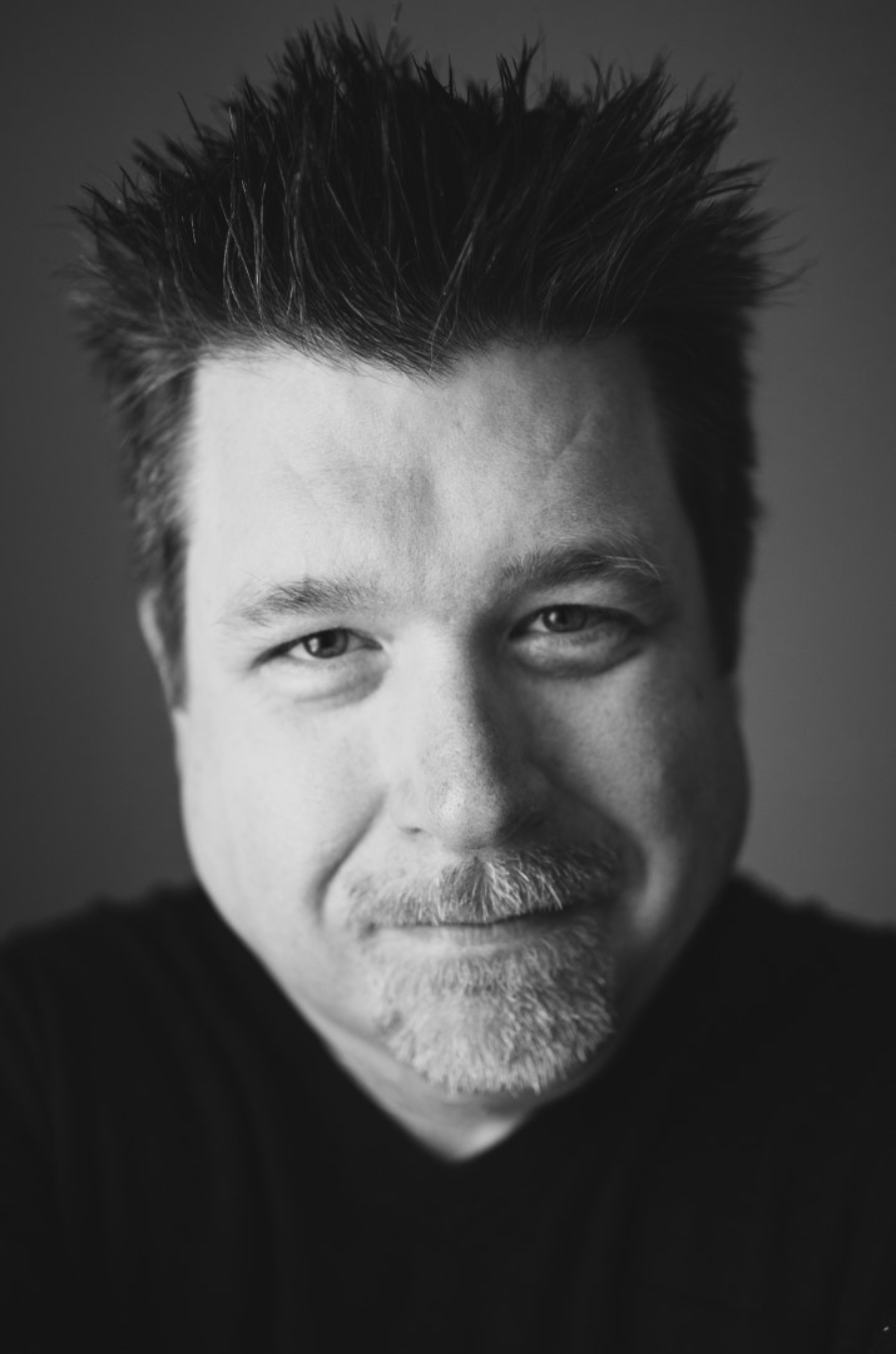
Below the Line: I just have to say, it was so nice to see Women Talking on a huge screen in Toronto, and I’m glad it’s coming out in theaters because this is a movie that needs to be seen on the big screen.
Luc Montpellier: Oh, great, thank you. I’m so happy you enjoyed it. It’s definitely a movie to be seen on the big screen, so I’m happy you were able to check that out at that scale.
BTL: Did you read Miriam’s book before coming onto the project?
Montpellier: I did read the book before coming onto the project. Yeah, it was a very informative thing to do just based on the ideas that Miriam was trying to translate and how Sarah was interpreting those things, so it was a very useful thing to do. But the book is very different. It all takes place in the loft and is told through a different narrator. So it was really interesting to see the choices made for the translation into a film medium, which to me is a challenge.
BTL: The first thing I noticed was the coloring. This whole thing feels like it’s taking place in a faded, colorless world.
Montpellier: Yeah, that was a very important thing that Sarah wanted to do. She wanted to convey the society, and how very conformist it is, through the photography. I also wanted to trick the audience that it was set in a timeless place, but it was actually a more modern world. Because at first, you watch the film [and] you think, ‘is this taking place in the 1800s? When is it taking place?’ But that was all very intentional to be able to draw you into that idea, but then throw little visual cues that it’s more in the modern world. So to me, starting with that desaturated palette was a very important thing to create a more gothic image so that when you’re experiencing this story, you instantly feel a certain way, very similar to how these women are feeling after this horrible act has occurred, and also just what they’ve had to endure all their lives.
This idea of the gothic image and how religion and faith play in the film, we just wanted to create this idea, like in the loft, that you’re very much, like, in a cathedral, as opposed to in the book, [which] indicates that it’s a much smaller space. It’s more clandestine. We took some liberties with that. That’s why the palette was that way, but also just letting a little bit of color seep through when we wanted you to really, in a non-judgmental way, feel the beauty of the colony.
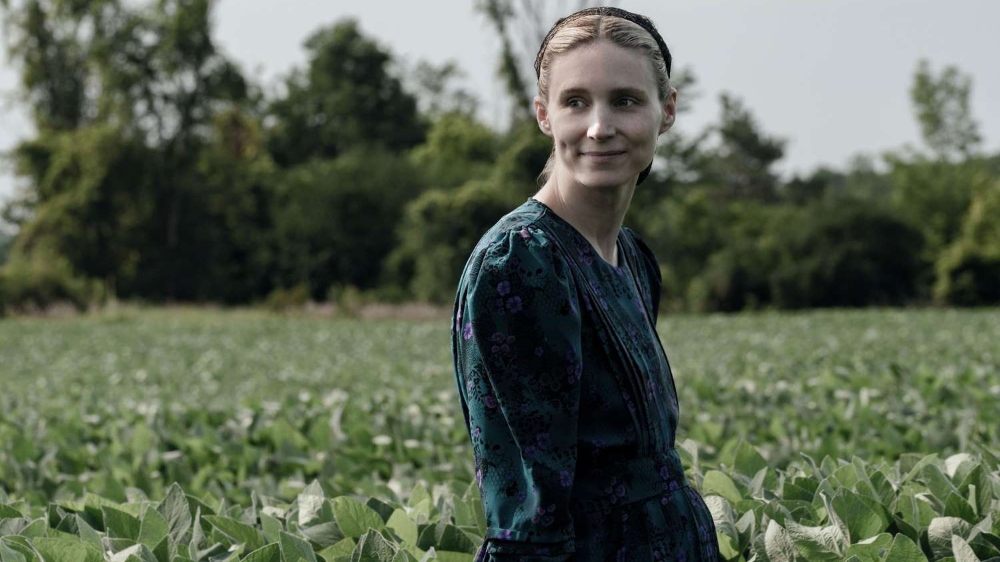
BTL: How did you use light to enhance that?
Montpellier: When you go outside, you were able to let some of that light and color seep through, [like] when the children were playing. We didn’t want it to be overly heavy even though it’s quite a repressive feel that you get. We also didn’t want to put judgment on it, so that’s why a bit of color was really important, to let those beautiful moments hopefully seep through for the audience.
Also, in the film, with the idea of adding a little bit more color, the clock ticking has a very important tension element to it, to add some tension to the story, that the men could come back any minute. It helped to feel this light shifting throughout the film and be able to really, hopefully, drive that home for the audience — that these men could arrive any minute.
So having that little bit of color also served as a tension element as well. We’re hoping that you felt all of those different things with the visual choice we made, and that, along with these amazing performances, it all blends together to create this feeling, which is what I think cinematography is. I know Sarah wanted the imagery in the film early on to reflect the epic nature of this decision that these women had to make, so she did not want to be passive with the photography, she really wanted us to be able to have the camera just drift outside and see the children playing after the debate just to give us a breath. All those decisions with color and movement, hopefully, the audience was there with us, [and we were] able to, as closely as we could, make you feel like you’re in that loft and living in that colony.
BTL: How did you accomplish that from a technical perspective?
Montpellier: This permission that we gave ourselves to be able to use camera movements to accentuate a moment without it being too heavy-handed. I am quite proud of the nuanced nature of camera movement. Sarah and I went through her script line-by-line and she handed me this amazing document that was basically all of the turning points within the film where things are being debated.
So we had this almost secondary script with just subtext to it, and we were able to look at that and say, ‘wouldn’t it be great if we cross the axis at this moment when Mariche (Jessie Buckley) is coming to the realization that she is as to blame as everyone else for her abuse, for letting it happen. We strategically move the camera at that point to underline this idea that life is going on even though this amazingly huge, heavy, decision needs to be made that will affect almost everyone in the colony we wanted. I know Sarah wanted this feeling that life is still happening outside. So the camera drifting out of the barn and just reminding us what people are fighting for, which a lot of it is the children.
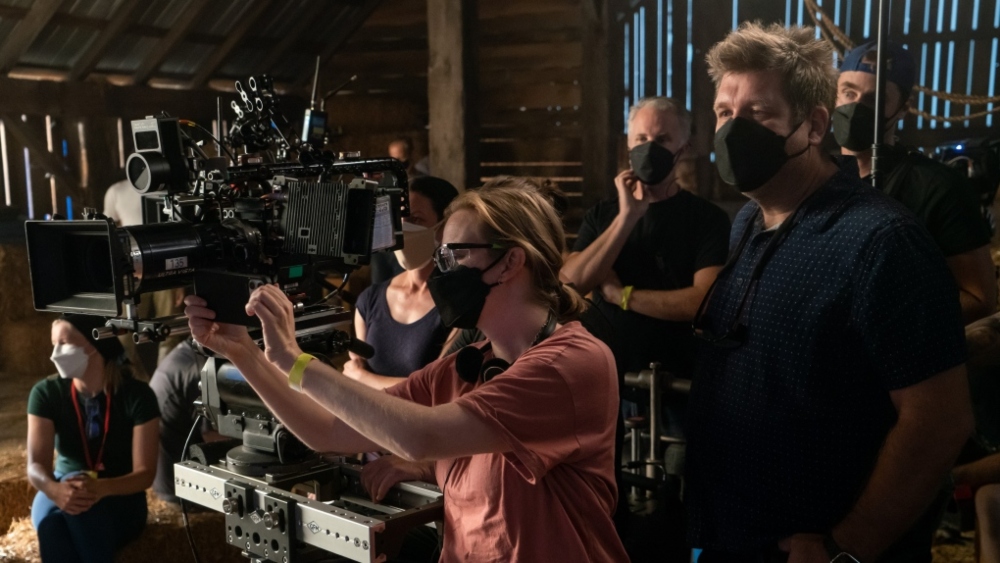
BTL: Did you use a particular lens to aid in that?
Montpellier: I thought it was important to shoot this in a very large-format anamorphic way. I had these special lenses on the film, Panavision manufacturers called Ultra Vistas, [which] are lenses that are rehoused old vintage glass, but they’re basically designed to shoot anamorphic but in a large-format kind of way. There are very few sets of these lenses that exist in the world because they’re very in demand. They give you a very specific quality, but I was able to get two of these sets of lenses for our film, which I spent almost a year tracking and testing and pleading with my friends at Panavision to let me use them. They’ve always been a big support.
But what we see a lot, especially with digital photography or just photography, is that there are a lot of large-format cameras out there, but the large-format anamorphic lenses are quite rare. When you shoot large-format non-anamorphic, you have a very specific out-of-focus quality to it which we’ve seen a lot of, but also, in the anamorphic, when you shoot that, you have that depth of field, but it’s very unique to the anamorphic lens. It’s a different kind of feeling, and there’s softness around the edges. So for me, these lenses represented the best of both worlds — I was able to shoot this lens, but also have quite a unique out-of-focus. It just matched this idea of what Sarah was saying about this epic nature.
BTL: It does feel epic, but there’s still such a focus on intimacy and specifics.
Montpellier: I wanted you to feel every pore in someone’s face, and I wanted you to be able to see every blade of grass outside that you went, just to put you there as much as you could, despite it being very fable-like, her film. I talked about the desaturation. It’s very much a commentary on this horrible event that happened in the past that’s based on a true event. For us, it was about making a comment on that and using it as a jumping-off point. In a way, we were able to take a lot of liberties visually. We weren’t shooting a documentary. We really wanted to bring you in, and hopefully start a conversation with you after the credits roll. So every decision was made that way.
There’s this amazing moment, with this idea that the clock is ticking and the light is subtly shifting throughout the whole film, in the middle of the film, where Little Miep, one of the young girls [who] we are introduced to, comes in to [see] her mother Salome (Claire Foy), and the women just sit there in silence after having debated these amazing things for half the film. Quite intense things have been said. But then right in the middle of the film, it was important that we just let the audience reflect on what they just saw so you’re not bombarding them with these huge ideas all the time. The film is very much like music that way. That’s what I just love [about] the script that Sarah wrote, that she adapted. It’s very lyrical that way, where there are movements within it, but there are quiet moments to just let you sink in. There are funny moments.
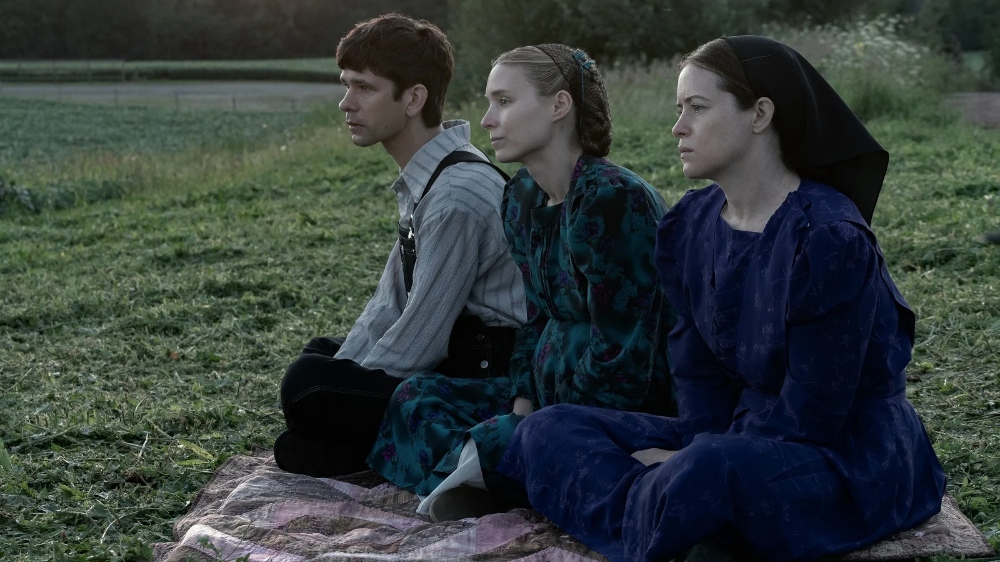
BTL: Are there any scenes that you feel particularly highlight your work?
Montpellier: In the middle of the film, when they’re all sitting there and they’re taking care of this little girl and forgetting everything that they have to do, despite the sun going down, one of my proudest moments was when we were able to adjust reality and have the sun setting in real-time. As opposed to, hopefully, it being just a beautiful image, it’s entirely based on story and what’s happening. That’s what I really get off on as a cinematographer — when all the elements are playing together. That, to me, was a shining moment, where you could sit back and say, ‘that looks amazing,’ but it’s more the subtext of what it was that really gets me going and wants me to continue to do these kinds of things.
The fine-tooth design I’m very proud of because it’s so very easy in a film with these astonishing actors, and I’ve always been awed, to just put a camera on everyone and close-up everywhere and then just edit it together later because they’re giving you so much. But I really have to hand it to Sarah. I really was excited for us to want to tell the story with a camera like a supporting actor as opposed to being just more passive and observing. That was what was special for me in the film, and almost more of a challenge, because you have to be in lock-step with these amazing characters and performance and dialogue. You don’t want to do the wrong thing. We didn’t shy away, obviously, from using the photography, and made some very big choices — like these women need to make in the movie.
BTL: You did a phenomenal job, and you obviously work so well with Sarah but was there ever any thought that this film should have a female photographer because of its themes?
Montpellier: Absolutely. That’s a very good question. I actually asked the exact same question of Sarah at the beginning of this process after I read the script. The film is called Women Talking. Our producing team… Frances McDormand got the rights to the book, it’s an all-female team. Also, it just deals very much with a lot of issues that women go through every day. So I had that same question for Sarah. I said I’d be willing to step back and let a female cinematographer take this on if you want, even though we have this long history [and] shorthand, but I understand that might be the best thing to do.
She said one simple thing to me, [which] is in the film as well. It’s very much life imitates art, in this case, and a lot of great stories do that in the way you make it. She said something simple. She goes, ‘listen, this is not only about women, it’s about everyone. It’s about all of our roles, all of our points of view, good and bad. If we want anything to shift, we need to be able to have these hard conversations, not just amongst women but with men as well. August (Ben Whishaw), the character, represents what a good man can be. He’s sensitive. He’s listening to them. It’s all right there on the screen.’ That’s what I needed to hear from her, beyond just having a working relationship.
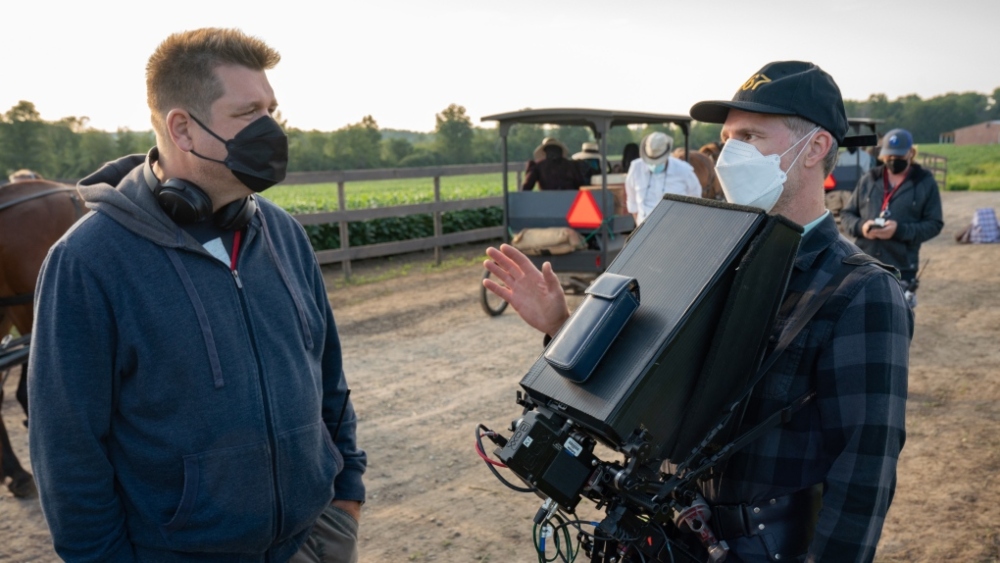
BTL: How does that play into the themes and messages of the film?
Montpellier: Everyone on this film, including myself, wanted to do the right thing for the world right now. This film is no doubt starting a conversation, and hopefully, when the credits roll, like I said, there [will be] a lot of people just sitting there. It’s just a heavy film. Sarah also never shies away from really asking or making very hard statements sometimes that might not always be popular, like it’s about everyone. It’s not just about women even though it’s called Women Talking. That’s what the entry point needed to be for me. And I identify with August’s character as well. I needed an entry point beyond her giving me her thoughts on a story level. It was August.
I’m from a small town. I’ve been around a lot of male masculinity and toxic masculinity in my life and luckily was able to move away, eventually, to a big city, and see that the world is way different. That, in combination with what she said, was what I needed, and I like this idea that the conversation is more nuanced as opposed to always just everyone’s on a team, all of us need to get together. More men need to see the film. Maybe subconsciously, I felt like I was part of a movement of trying to do that.
I have a 14-year-old daughter. I want a better world for her, and this film is asking questions that are tough. We tried to have as diverse a crew as possible, and what I told to all the men on the crew was that our role on this film is to listen, very much like in life, and to stay open, and to try to bring this story that these amazing women have put together to the screen. We had a lot of discussion about what our roles were going to be.
I have to hand it to Sarah. In life, she’s a true human being [who] really wants to change things, and to try to add [to] that conversation. It includes all of us. [We’re] asking hard questions in the movie. We have to be able to find a way to do it. And I’m no exception. Believe me, I knew I would probably be getting this kind of question because it’s an obvious thing. I thought a lot about if I should be here or not, but I just really feel privileged to have been here for this.
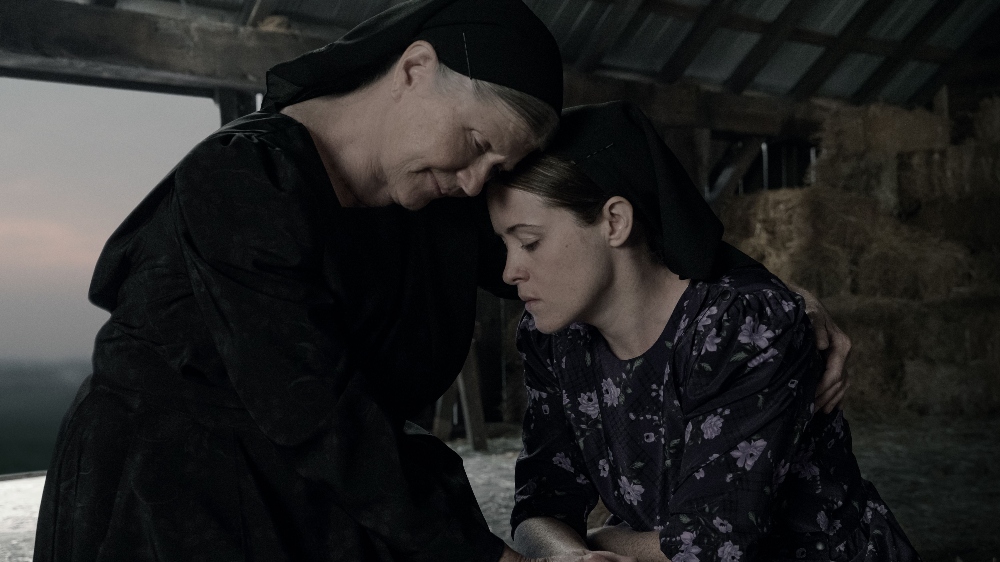
BTL: With our remaining time, I need to ask you about one of my favorite short-lived shows that I know you worked on, J.K. Simmons’ Starz series Counterpart. I loved that show, and as soon as I think about it, I remember the two different worlds and how close they had to look to each other, but just slightly different. What can you tell me about the experience of working on that show?
Montpellier: That show was probably the most complex, technically, that I’ve ever worked on. The scripts were so intelligently written and nuanced that it took me four or five reads of the script to really delve into the story. There was also a lot of consideration [regarding] technology. We used a lot of motion control to be able to shoot J.K. Simmons playing against himself. How do you not get in the way too much of this because it’s such a difficult thing that he had to do. He had to shoot one side, then hear himself for the other side, and time everything out. It was just such a technical feat. The thing I was most proud of is that we found a way to not let that get in the way. That goes [for] everything that I do. I hope I can disappear even though it might be complex and there’s this huge magic machine happening in the background. Hopefully, I can create that tone for the actors because I’m in awe of what they do. I think it’s the conduit to a lot of people’s humanity, and hopefully, I can support that.
On Counterpart, I love the attempt of trying to go into a very high-concept piece of work and find the right design for it between the two worlds. How do you communicate a history between two dimensions having a cold war with each other but not revealing everything right off the top? So the palette was very important with that, that one side has had this huge pandemic, and there’s been a huge disease that’s affected everyone and killed a lot of people, and they think the other side did it. How do you convey that?
And also this idea that this bad experiment happened in the ’80s, so that everything is frozen at that time in the threshold, was quite a genius thing. With cinematography, how does it convey an honest story? I once said that about the show when I was asked about it. Hopefully, I brought an honesty to the photography, but then it happens to be in a science-fiction world. I shot a show called Tales From the Loop, a few episodes of that, where it was very similar. Even though it was sci-fi, we almost needed to ignore it and just tell this great story.
Women Talking will be released in select theaters on Dec. 23 via MGM and United Artists Releasing.





